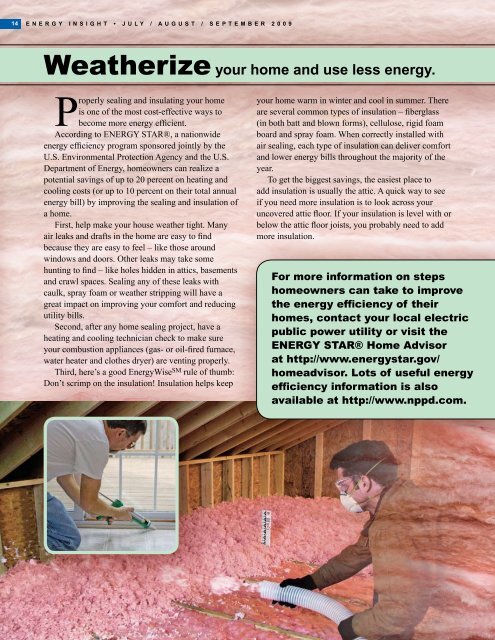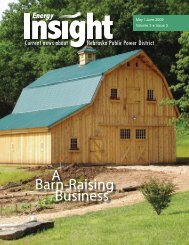July / Aug. / Sept. 2009 - Nebraska Public Power District
July / Aug. / Sept. 2009 - Nebraska Public Power District
July / Aug. / Sept. 2009 - Nebraska Public Power District
You also want an ePaper? Increase the reach of your titles
YUMPU automatically turns print PDFs into web optimized ePapers that Google loves.
14<br />
ENERGY INSIGHT • JULY / AUGUST / SEPTEMBER <strong>2009</strong><br />
Weatherize your home and use less energy.<br />
Properly sealing and insulating your home<br />
is one of the most cost‑effective ways to<br />
become more energy efficient.<br />
According to ENERGY STAR®, a nationwide<br />
energy efficiency program sponsored jointly by the<br />
U.S. Environmental Protection Agency and the U.S.<br />
Department of Energy, homeowners can realize a<br />
potential savings of up to 20 percent on heating and<br />
cooling costs (or up to 10 percent on their total annual<br />
energy bill) by improving the sealing and insulation of<br />
a home.<br />
First, help make your house weather tight. Many<br />
air leaks and drafts in the home are easy to find<br />
because they are easy to feel – like those around<br />
windows and doors. Other leaks may take some<br />
hunting to find – like holes hidden in attics, basements<br />
and crawl spaces. Sealing any of these leaks with<br />
caulk, spray foam or weather stripping will have a<br />
great impact on improving your comfort and reducing<br />
utility bills.<br />
Second, after any home sealing project, have a<br />
heating and cooling technician check to make sure<br />
your combustion appliances (gas- or oil-fired furnace,<br />
water heater and clothes dryer) are venting properly.<br />
Third, here’s a good EnergyWise SM rule of thumb:<br />
Don’t scrimp on the insulation! Insulation helps keep<br />
your home warm in winter and cool in summer. There<br />
are several common types of insulation – fiberglass<br />
(in both batt and blown forms), cellulose, rigid foam<br />
board and spray foam. When correctly installed with<br />
air sealing, each type of insulation can deliver comfort<br />
and lower energy bills throughout the majority of the<br />
year.<br />
To get the biggest savings, the easiest place to<br />
add insulation is usually the attic. A quick way to see<br />
if you need more insulation is to look across your<br />
uncovered attic floor. If your insulation is level with or<br />
below the attic floor joists, you probably need to add<br />
more insulation.<br />
For more information on steps<br />
homeowners can take to improve<br />
the energy efficiency of their<br />
homes, contact your local electric<br />
public power utility or visit the<br />
ENERGY STAR® Home Advisor<br />
at http://www.energystar.gov/<br />
homeadvisor. Lots of useful energy<br />
efficiency information is also<br />
available at http://www.nppd.com.









